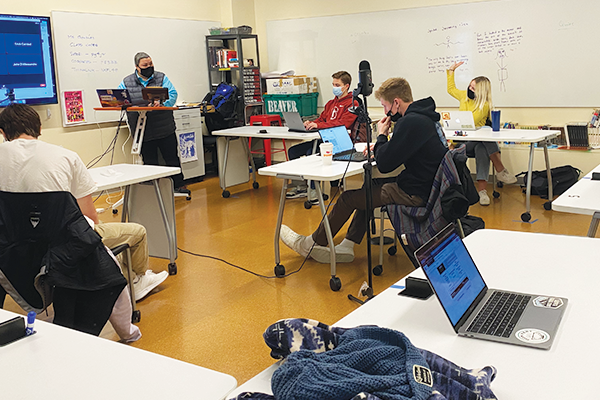When I walked into the Think Tank (a conference room with glass walls in the Research and Design Center), the only sign of Yolanda Wilcox González—head of the Global History department and US history teacher—was her backpack. She left it on one of the chairs parked at the high top table we would soon talk around. Before she came back, I peeked out of the room, looked both ways down the hall, and put my things down in the empty “tank” occupied only by Ms. González’s backpack. I heard her voice laughing with a student before I saw her come in and take the seat her backpack had reserved.
Only after speaking with Ms. González did I decide that the “Think Tank” was aptly named; Ms. González provided the “think.” Talking with her was like talking to a fountain of educational wisdom that never runs dry.
Current events are intrinsically intertwined in what Ms. González does for a living; every historical event is a nerve connected to something going on right now. With Ms. González, students can’t help but pulse from one historical idea to another and recognize the connection between each one.
“As the kids look at environmental justice, worker’s rights, LGBTQIA+ inclusion, they’re looking at what it means for immigrant rights, reproductive rights, etc. Is the feminist movement inclusive? At the Women’s March in 2016, how accessible was this event to those in wheelchairs or hearing impaired? And so on and so forth,” Ms. González said.
These are just some of the infinite collection of questions posed in her class.
During our conversation, Ms. González moved frequently from one idea to another, yet everything she articulated made complete sense. After speaking with her for 20 minutes, I witnessed what her class dives into each day: a sea of ideas where the past pushes waves that become the future, and the chronological order of events matters drastically less than how one flows into one another.
“In order for me to talk about the past, I have to talk about the present,” she said. “That’s the piece that really engages students.
Ms. Gonzalez talked about how the anti-blackness and anti-semitism of the 1920s and 1930s were on full display on January 6 at the Capital Insurrection. We saw the past “first hand in the present.”
She didn’t bring this up to simply teach it, though. González integrates the present to ask students to take action; she inspires her students to be “change-agents.”
“All of us, at some point, were not part of the narrative that is America. Who’s in, who’s out, how do people create a sense of belonging?”
Before Ms. González dashed off to help two students with their student-directed projects, she filled me in on what they’re doing: two separate explorations in opposition to solitary confinement. In this, she proved her impact on students; after taking her class, they couldn’t help but ask her to advise their initiatives to make positive change.
Although she tapped into historical events that ranged from the 1920s and 1930s to two weeks ago, Yolanda had more to say. She joked that “she had to stop herself” from talking about all the different facets of her class and teaching philosophy—we covered trauma-informed pedagogy, the Dakota Access Pipeline, confirmation bias, the formation of the NAACP, juvenile justice, and so many other massive concepts. Every idea was attached to another. After talking to her, it seemed obvious that Ms. González is not simply a history teacher. She is a change-maker that inspires change-makers.
As she walked to her next meeting, her backpack got smaller and smaller. She blended seamlessly into the sea of students nearby, each toting a backpack themselves. She, although an accomplished and beloved teacher of more than 20 years, has a backpack just like them. Ms. González is a student of the world that can’t help but ask others to become one, too.
— Lizzie Conklin is an intern at Beaver Country Day School and assistant to painter Joel Janowitz. She is currently interning in various departments at Beaver—including Visual Arts and Marketing. She hopes to one day be an artist.

